G
Golem
Guest
(Ocarina of Time.)
These screenshots are from vids by this guy named OPFFIX on YouTube. They were very helpful in writing up my thoughts on the Fire Temple! I uh... I'm not trying to advertise for him, LOL, but I want to give credit where credit's due. The walkthroughs on zeldadungeon.net actually look pretty comprehensive, I might use them for further research.
The paragraphs below may sound a little weird, but that's because I wrote them for some other place. However, myself being a newbie to Zelda, I'd like to hear your thoughts on these paragraphs. I'd be grateful for any corrections or insights you could make! Not because I want to change what I've got written here, but I just want to learn. Zelda's got deep, rewarding gameplay, and I'm really scratching at the surface here.
Oh, and I kind of rushed through the part about the Water Temple. It's my favorite dungeon in the game , but when I got to that part I was just OUT OF STEAM from having written so much on the Fire Temple.
, but when I got to that part I was just OUT OF STEAM from having written so much on the Fire Temple.
I'm also sorry if this violates some sort of image limit for this message board. I couldn't find any limits referenced in the rules, so I'm assuming what I've posted here is fine. If it's not, I apologize!
---
The dungeons in Ocarina of Time all have distinct construction. Dungeons are constructed cohesively. Rooms interact with each other in a way unique to their respective dungeons, and the construction of any given room is unique to its dungeon as well. To put it more clearly: you couldn't take one room from the Forest Temple and put it in the Fire Temple. It would be out of place.
To prove this, I'd like to flesh out two dungeons that seem to be opposites. Interestingly, they are next to each other in the sequence of dungeons: the Fire Temple and the Water Temple.
The Fire Temple is built around strong hub rooms. Hub rooms act as central rooms with many outgoing paths, just as the castle acts as a hub in Super Mario 64 with many outgoing paths to different stages. When I say that these hub rooms are strong, I mean that they are detailed and that a large portion of time is spent in them. There are three of these hub rooms in the Fire Temple.
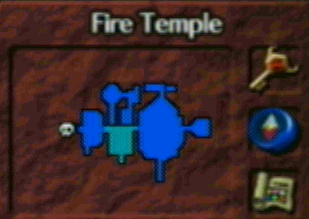
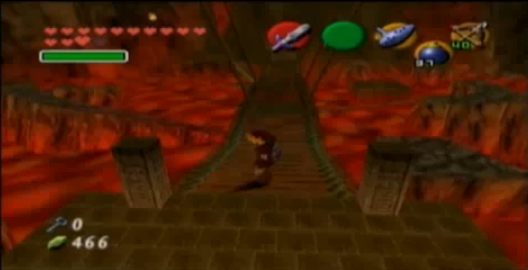
The first is just east of the opening room. On the map, it's an egg-shaped room towards the east. Just by looking at the map, you can see how this acts as a strong hub room. First, it's large, which suggests its strength. This room is a series of platforms (a bridge, some stray rocks, some stray platforms) and challenges the player with a pit of lava below; the player must take care in getting across this room, displaying its strength. The map also displays that it acts as a hub room; from here, the player moves forward to three other rooms.
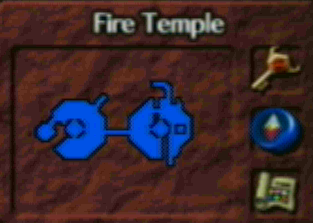
There are two strong hubs on the third floor. The first one you encounter is the room towards the east (the right semicircle of the eastern circle).
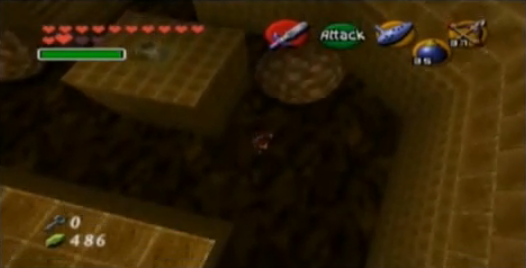
Again, it's large, which suggests strength, and it also has multiple outward paths. This room puts Link in a maze where he must avoid rolling boulders. In addition, he returns to this room to walk along the top of the maze. This room also links to the left semicircle in three places, while the left semicircle itself provides a path onward. The left semicircle may be considered a strong room, as it engages the player to outrace a fire barrier, but its layout is simplistic compared to the hubs of this dungeon--Link outraces the flame on a fairly linear path. This room should be considered a path room, an idea I'll return to later.

The third strong hub is the large western room on the third floor. It's a large room, and it has multiple outward paths. The strength of this room lies in another maze technique, this time showing the borders of the maze only as Link draws near them. In addition, these borders are made of damaging fire.
Admittedly, the opening room breaks this formula. It acts as a hub room, leading you to many other rooms, but its own design is simplistic--there are no obstacles in your traversal of this room. Rather, it leads to strong rooms. Also, there is a path on the north side which loops back into the entry room, which is arguably an element more reminiscent of the Forest Temple. It may also be worth noting that this northern path is near the end of one's visit to the Fire Temple; here, one gets the boss key, the last thing necessary in this dungeon before facing the boss. The tone of this dungeon, then, changes only at its end--is this a purposeful move? Why would would someone make that call? It's a question to consider.
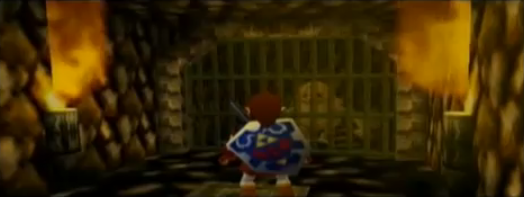
These hub rooms lead out often to small rooms with a single purpose: giving Link a key. However, there are two crucial exceptions. First, there are rooms create a path between hub rooms These involve simple puzzles, such as setting off a switch from a distance using a bomb.
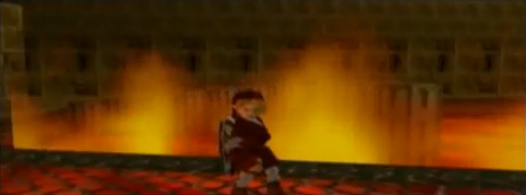
One merely involves danger, the room where Link must outrun a barrier of flame. While these rooms do have substance, they don't demand as much time from the player as the hub rooms. Second, the room containing the hammer has the complexity of a path room; it places one obstacle in Link's path.

However, the room leads nowhere, and in a sense, this is the end of the dungeon. On the whole, these non-hub rooms either offer no or zero obstacles, while Link must face the obstacles of hub rooms again and again.
The gimmicks of this dungeon rarely center around an item Link owns. For instance, some path rooms require Link to set off a switch with a bomb. However, most of the rooms--and most importantly, every hub room--has a gimmick which does not require the use of an item. The three hub rooms are crossed by walking alone. In part, this makes sense due to the dungeon's place in the game's sequence. Link received weapons he used to a great extent in the Forest Temple, but since then, he has only received the Fire Tunic, which allows him to withstand high temperatures. That doesn't change gameplay at all, as it merely prevents the player from getting a game over in hot rooms, nothing more. Also, the item of this dungeon is the hammer, which is only used in this dungeon to hit certain switches. However, Link has hit many switches as it is, and this hardly changes up gameplay either. However, it also makes sense given the structure of the dungeon. If the puzzles of the hub rooms were complex, the player would be solving complex puzzles every time they need to get across the hub room. Say a given hub room leads out to four other rooms. If that hub room contains a complex puzzle, in order to hit every outgoing room, I would need to clear the puzzles within the hub room four times. Alternatively, if the puzzles only needed to be solved once, the hub room would become bland after the first traversal. The approach of the Fire Temple engages the player each time without annoying him/her with repetitive puzzles.
Here we have some good criteria for analyzing a dungeon's construction. One, what are its hub rooms like? Two, the dead-end rooms that hubs go out to? Three, the path rooms that hubs go out to? Four, what are the gimmicks used within the dungeon? With that guideline in mind, let's have a go at the Water Temple.
Hub rooms? There's only one hub in the Water Temple, that circular room at the bottom right. It involves no puzzles and is only used to access other rooms.
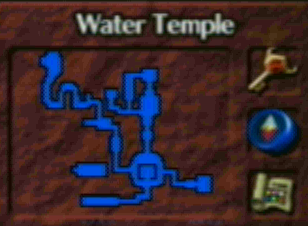
The outgoing rooms often are not paths, but instead dead ends. Also, traversing them takes great care--just by looking at the Water Temple map, they take up much more space than the hub room. One room, for instance, has you use the hookshot to ascend a series of descending platforms. Another has you use the metal boots to escape a whirlpool, hookshot across the room to reach a ledge you can't swim to, hit a switch, and finally fight some enemies. These rooms are detailed, and they require the use of items. They do a good job of offering a new gameplay experience, as well--players must sometimes mix use of the metal boots and swimming in order to navigate whirlpools. This actively engages the player in the task of swimming, something that Ocarina of Time otherwise glosses over. The Water Temple does this safely by making these rooms offshoots of a hub; there is no need to retraverse these rooms, so they may become detailed and involve complex puzzles.
This leaves a number of questions unanswered. For instance, why is Dark Link the miniboss of the Water Temple, and not some other dungeon? However, I think I at least have a start here.
These screenshots are from vids by this guy named OPFFIX on YouTube. They were very helpful in writing up my thoughts on the Fire Temple! I uh... I'm not trying to advertise for him, LOL, but I want to give credit where credit's due. The walkthroughs on zeldadungeon.net actually look pretty comprehensive, I might use them for further research.
The paragraphs below may sound a little weird, but that's because I wrote them for some other place. However, myself being a newbie to Zelda, I'd like to hear your thoughts on these paragraphs. I'd be grateful for any corrections or insights you could make! Not because I want to change what I've got written here, but I just want to learn. Zelda's got deep, rewarding gameplay, and I'm really scratching at the surface here.
Oh, and I kind of rushed through the part about the Water Temple. It's my favorite dungeon in the game
 , but when I got to that part I was just OUT OF STEAM from having written so much on the Fire Temple.
, but when I got to that part I was just OUT OF STEAM from having written so much on the Fire Temple.I'm also sorry if this violates some sort of image limit for this message board. I couldn't find any limits referenced in the rules, so I'm assuming what I've posted here is fine. If it's not, I apologize!
---
The dungeons in Ocarina of Time all have distinct construction. Dungeons are constructed cohesively. Rooms interact with each other in a way unique to their respective dungeons, and the construction of any given room is unique to its dungeon as well. To put it more clearly: you couldn't take one room from the Forest Temple and put it in the Fire Temple. It would be out of place.
To prove this, I'd like to flesh out two dungeons that seem to be opposites. Interestingly, they are next to each other in the sequence of dungeons: the Fire Temple and the Water Temple.
The Fire Temple is built around strong hub rooms. Hub rooms act as central rooms with many outgoing paths, just as the castle acts as a hub in Super Mario 64 with many outgoing paths to different stages. When I say that these hub rooms are strong, I mean that they are detailed and that a large portion of time is spent in them. There are three of these hub rooms in the Fire Temple.


The first is just east of the opening room. On the map, it's an egg-shaped room towards the east. Just by looking at the map, you can see how this acts as a strong hub room. First, it's large, which suggests its strength. This room is a series of platforms (a bridge, some stray rocks, some stray platforms) and challenges the player with a pit of lava below; the player must take care in getting across this room, displaying its strength. The map also displays that it acts as a hub room; from here, the player moves forward to three other rooms.

There are two strong hubs on the third floor. The first one you encounter is the room towards the east (the right semicircle of the eastern circle).

Again, it's large, which suggests strength, and it also has multiple outward paths. This room puts Link in a maze where he must avoid rolling boulders. In addition, he returns to this room to walk along the top of the maze. This room also links to the left semicircle in three places, while the left semicircle itself provides a path onward. The left semicircle may be considered a strong room, as it engages the player to outrace a fire barrier, but its layout is simplistic compared to the hubs of this dungeon--Link outraces the flame on a fairly linear path. This room should be considered a path room, an idea I'll return to later.

The third strong hub is the large western room on the third floor. It's a large room, and it has multiple outward paths. The strength of this room lies in another maze technique, this time showing the borders of the maze only as Link draws near them. In addition, these borders are made of damaging fire.
Admittedly, the opening room breaks this formula. It acts as a hub room, leading you to many other rooms, but its own design is simplistic--there are no obstacles in your traversal of this room. Rather, it leads to strong rooms. Also, there is a path on the north side which loops back into the entry room, which is arguably an element more reminiscent of the Forest Temple. It may also be worth noting that this northern path is near the end of one's visit to the Fire Temple; here, one gets the boss key, the last thing necessary in this dungeon before facing the boss. The tone of this dungeon, then, changes only at its end--is this a purposeful move? Why would would someone make that call? It's a question to consider.

These hub rooms lead out often to small rooms with a single purpose: giving Link a key. However, there are two crucial exceptions. First, there are rooms create a path between hub rooms These involve simple puzzles, such as setting off a switch from a distance using a bomb.

One merely involves danger, the room where Link must outrun a barrier of flame. While these rooms do have substance, they don't demand as much time from the player as the hub rooms. Second, the room containing the hammer has the complexity of a path room; it places one obstacle in Link's path.

However, the room leads nowhere, and in a sense, this is the end of the dungeon. On the whole, these non-hub rooms either offer no or zero obstacles, while Link must face the obstacles of hub rooms again and again.
The gimmicks of this dungeon rarely center around an item Link owns. For instance, some path rooms require Link to set off a switch with a bomb. However, most of the rooms--and most importantly, every hub room--has a gimmick which does not require the use of an item. The three hub rooms are crossed by walking alone. In part, this makes sense due to the dungeon's place in the game's sequence. Link received weapons he used to a great extent in the Forest Temple, but since then, he has only received the Fire Tunic, which allows him to withstand high temperatures. That doesn't change gameplay at all, as it merely prevents the player from getting a game over in hot rooms, nothing more. Also, the item of this dungeon is the hammer, which is only used in this dungeon to hit certain switches. However, Link has hit many switches as it is, and this hardly changes up gameplay either. However, it also makes sense given the structure of the dungeon. If the puzzles of the hub rooms were complex, the player would be solving complex puzzles every time they need to get across the hub room. Say a given hub room leads out to four other rooms. If that hub room contains a complex puzzle, in order to hit every outgoing room, I would need to clear the puzzles within the hub room four times. Alternatively, if the puzzles only needed to be solved once, the hub room would become bland after the first traversal. The approach of the Fire Temple engages the player each time without annoying him/her with repetitive puzzles.
Here we have some good criteria for analyzing a dungeon's construction. One, what are its hub rooms like? Two, the dead-end rooms that hubs go out to? Three, the path rooms that hubs go out to? Four, what are the gimmicks used within the dungeon? With that guideline in mind, let's have a go at the Water Temple.
Hub rooms? There's only one hub in the Water Temple, that circular room at the bottom right. It involves no puzzles and is only used to access other rooms.

The outgoing rooms often are not paths, but instead dead ends. Also, traversing them takes great care--just by looking at the Water Temple map, they take up much more space than the hub room. One room, for instance, has you use the hookshot to ascend a series of descending platforms. Another has you use the metal boots to escape a whirlpool, hookshot across the room to reach a ledge you can't swim to, hit a switch, and finally fight some enemies. These rooms are detailed, and they require the use of items. They do a good job of offering a new gameplay experience, as well--players must sometimes mix use of the metal boots and swimming in order to navigate whirlpools. This actively engages the player in the task of swimming, something that Ocarina of Time otherwise glosses over. The Water Temple does this safely by making these rooms offshoots of a hub; there is no need to retraverse these rooms, so they may become detailed and involve complex puzzles.
This leaves a number of questions unanswered. For instance, why is Dark Link the miniboss of the Water Temple, and not some other dungeon? However, I think I at least have a start here.
Last edited by a moderator:


